- Learn about districts
- Advance a district
- Who we work with
- Advance with us
- Connect
-
Ready to amplify your district’s impact?
Join the Network
- About us
Our Theory of Change
In their 2014 report The Rise of Innovation Districts, Bruce Katz and Julie Wagner introduced a simple yet powerful framework to explain how innovation districts take shape. They identified three starting assets: economic, physical and networking assets.
This chart visualizes their original insight showing how firms and institutions, built environments, and human connections intersect to create fertile ground for innovation ecosystems.
However, these foundational assets alone do not define an innovation district’s unique value because it is the intentional combination, alignment, and activation of these assets that truly drives their distinctive potential.
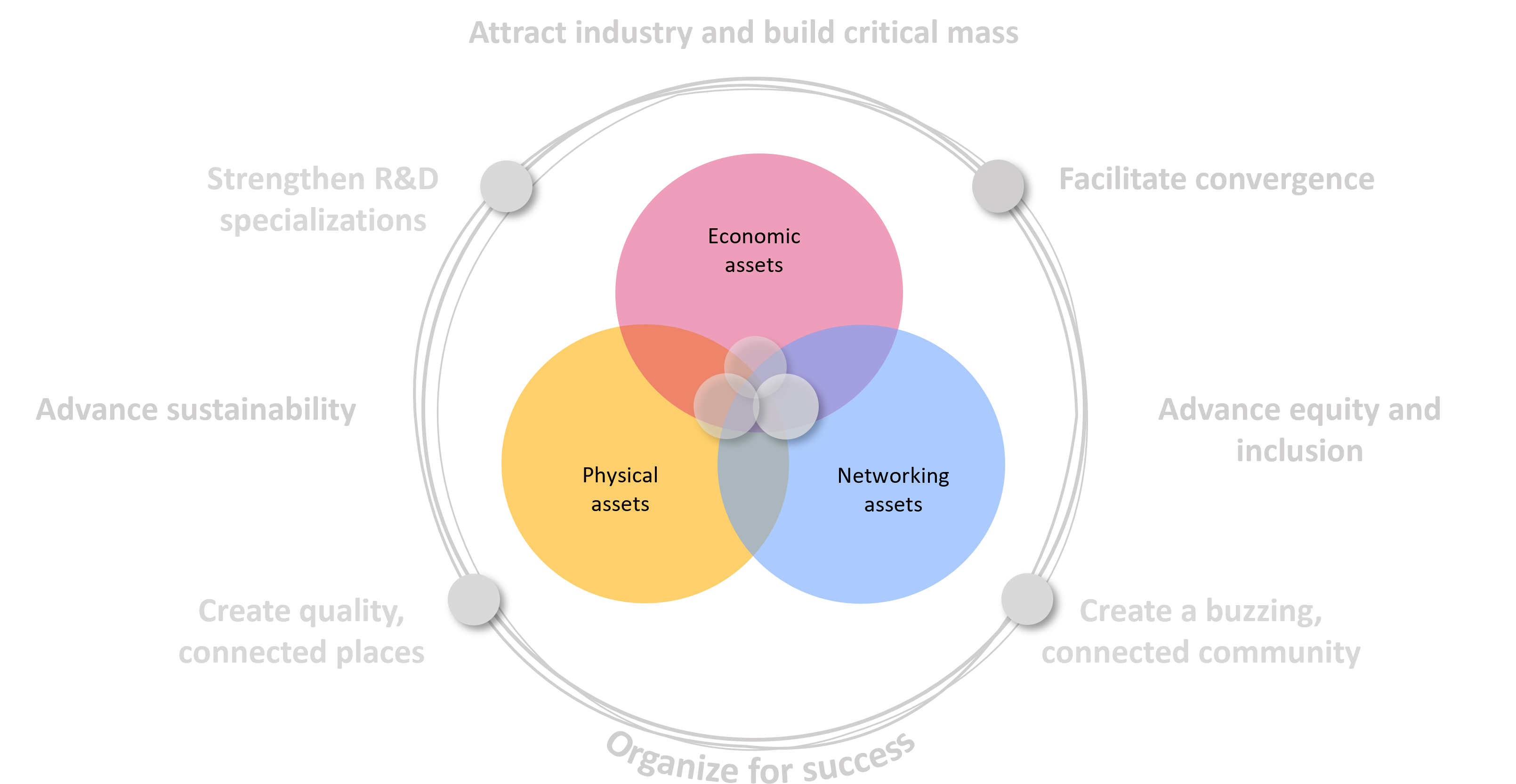
Strategies for strengthening a district’s Unique Value Proposition
At GIID, research on and engagement with districts have led us to further develop the framework for transforming the three starting assets into a set of highly coordinated strategies and tactics. Click the buttons below to learn more about each strategy.
Strengthen R&D specializations
identifying your district’s R&D strengths and niches with real specificity to highlight where you excel regionally or nationally.
This means moving away from broad fields of sectors to strong or emerging specializations.
In 2016, at least 54 nations boasted of possessing at least one biotechnology hub. North America alone identified over 30. A review of the leading hubs for bioelectronics or immunotherapy in transplant or orphan drug development yields a much smaller list.
There’s value in identifying R&D niches to develop a clearer competitive advantage.
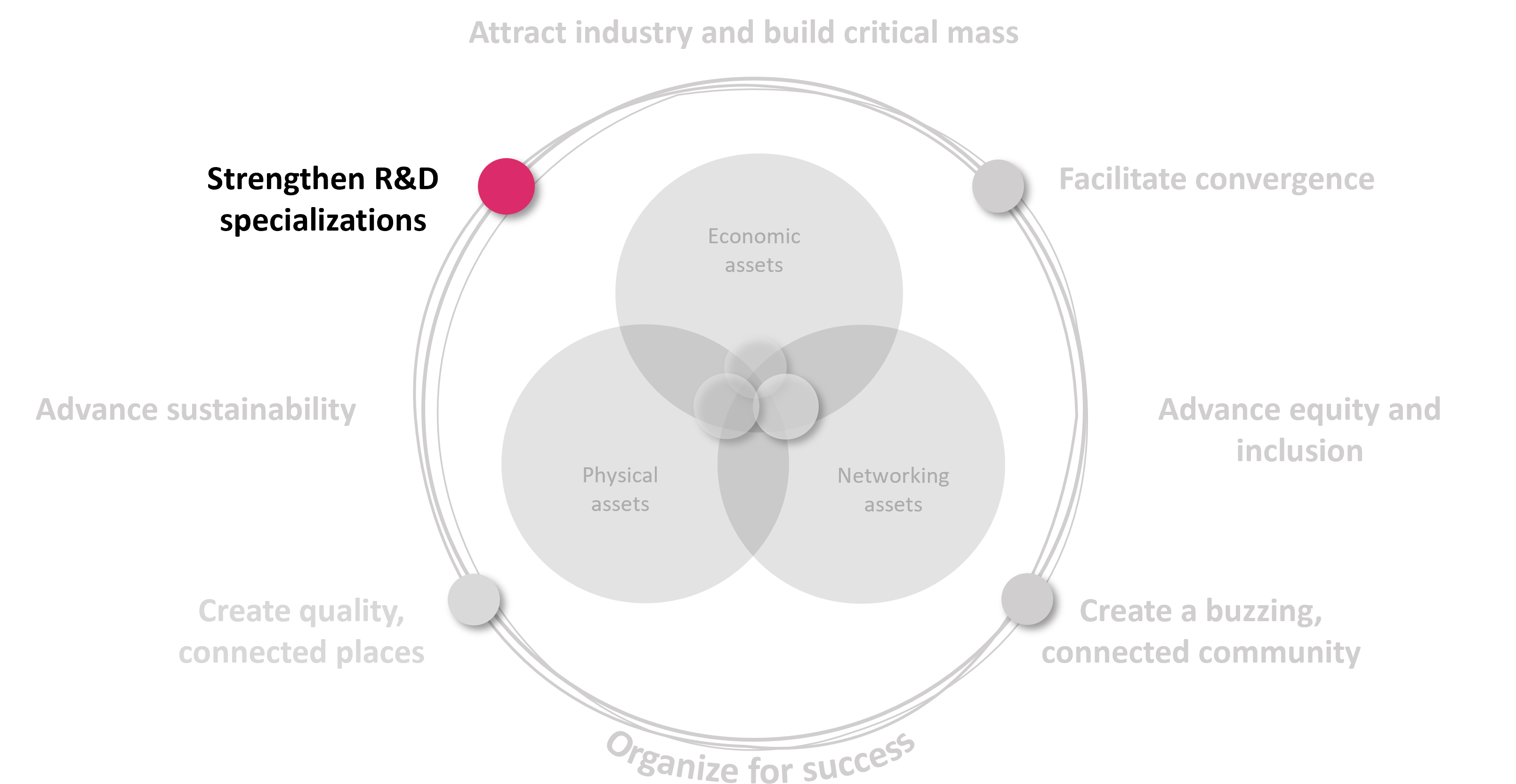
Facilitate convergence
fostering unconventional combinations of expertise from different disciplines to catalyze scientific and technological breakthroughs.
Some of the most exciting developments in cancer treatment in recent years have involved combining expertise from oncology and immunology. The earliest and most effective Covid-19 vaccines were derived from a mashup of expertise from virology, genetics, and computational science. Research on the next generation of supercomputers combines knowledge and ideas from quantum physics and information science.
Our research examines the extent to which districts are achieving unique forms of convergence and, likely, spawning specific competitive advantages.
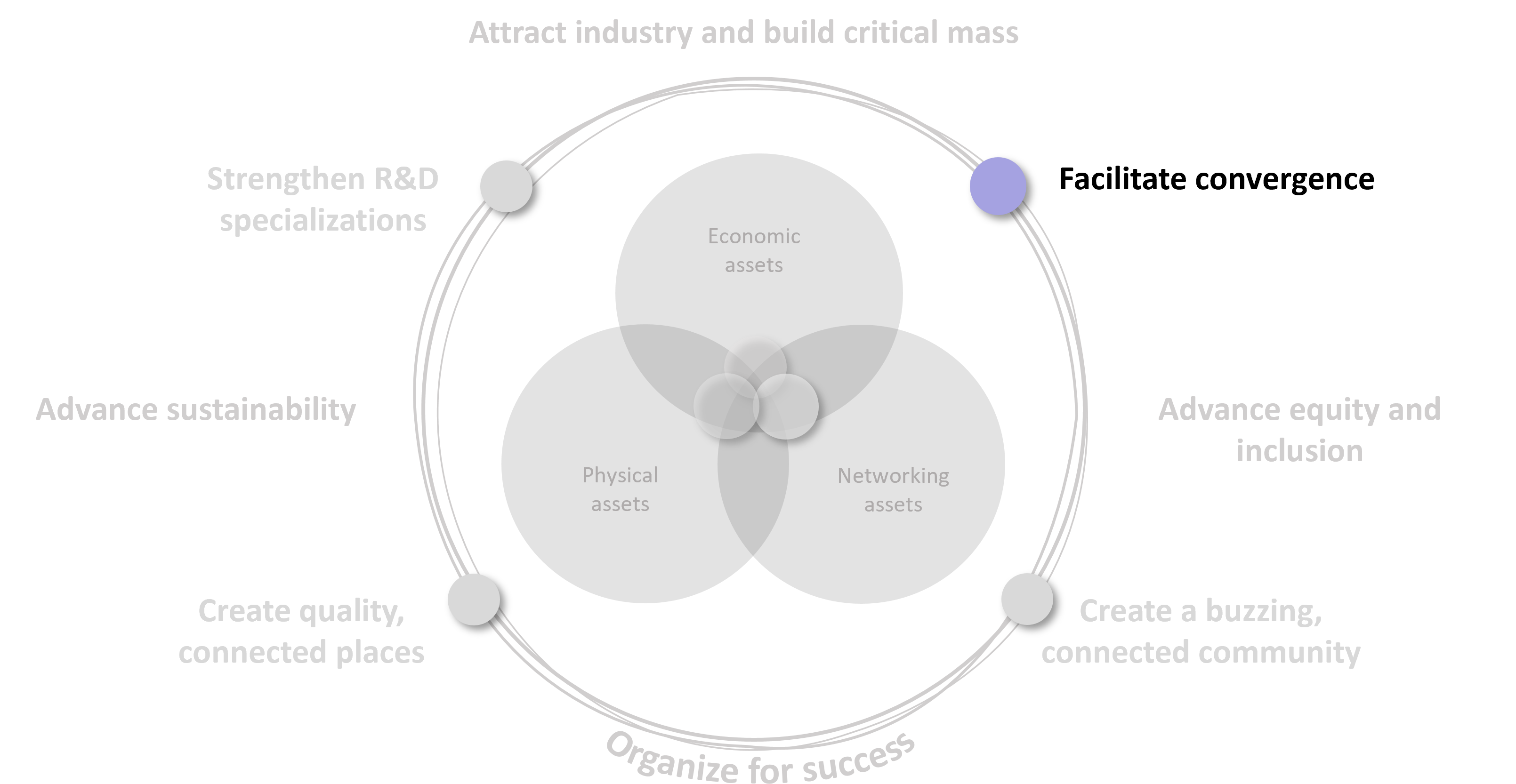
Create a buzzing, connected community
establishing shared systems and orchestrated networks to foster community ties and keep people bound to these places.
Practitioners leading mature innovation districts share how the growth and development of networks through programming has transformed their real estate into buzzing, connected communities.
Creating a buzzing community means placing a priority on informal and formal social networks between different district actors, including residents. Social networks are shaped and grown through different social programs such as training, networking events, and fun activities.
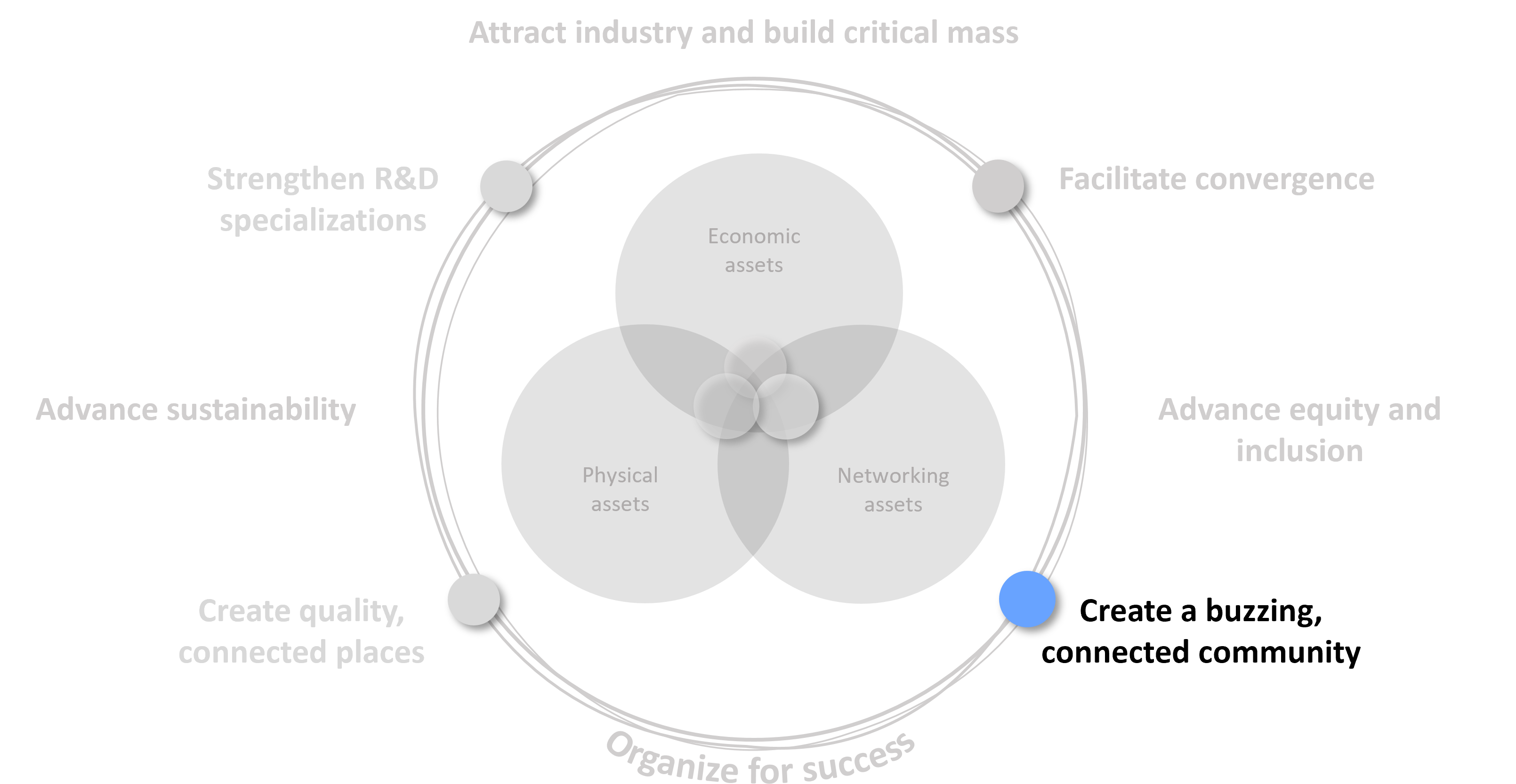
Create quality, connected places
leveraging physical assets to attract firms and talent, strengthen connections, and increase vibrancy.
Physical proximity, density, and highly connected environments grow in importance. They impact how innovation districts facilitate knowledge exchange, spurring a greater focus on “place”. Districts are investing considerable resources to ensure high quality, people-centered designs, increased walkability, and greater accessibility.
The work requires district leaders to think about place as an enabler for:
– Drawing together companies with institutional researchers.
– Educating and training residents into meaningful employment.
– Inviting a diversity of people—including children—into the spaces to test ideas, to ask questions, and to own the space.
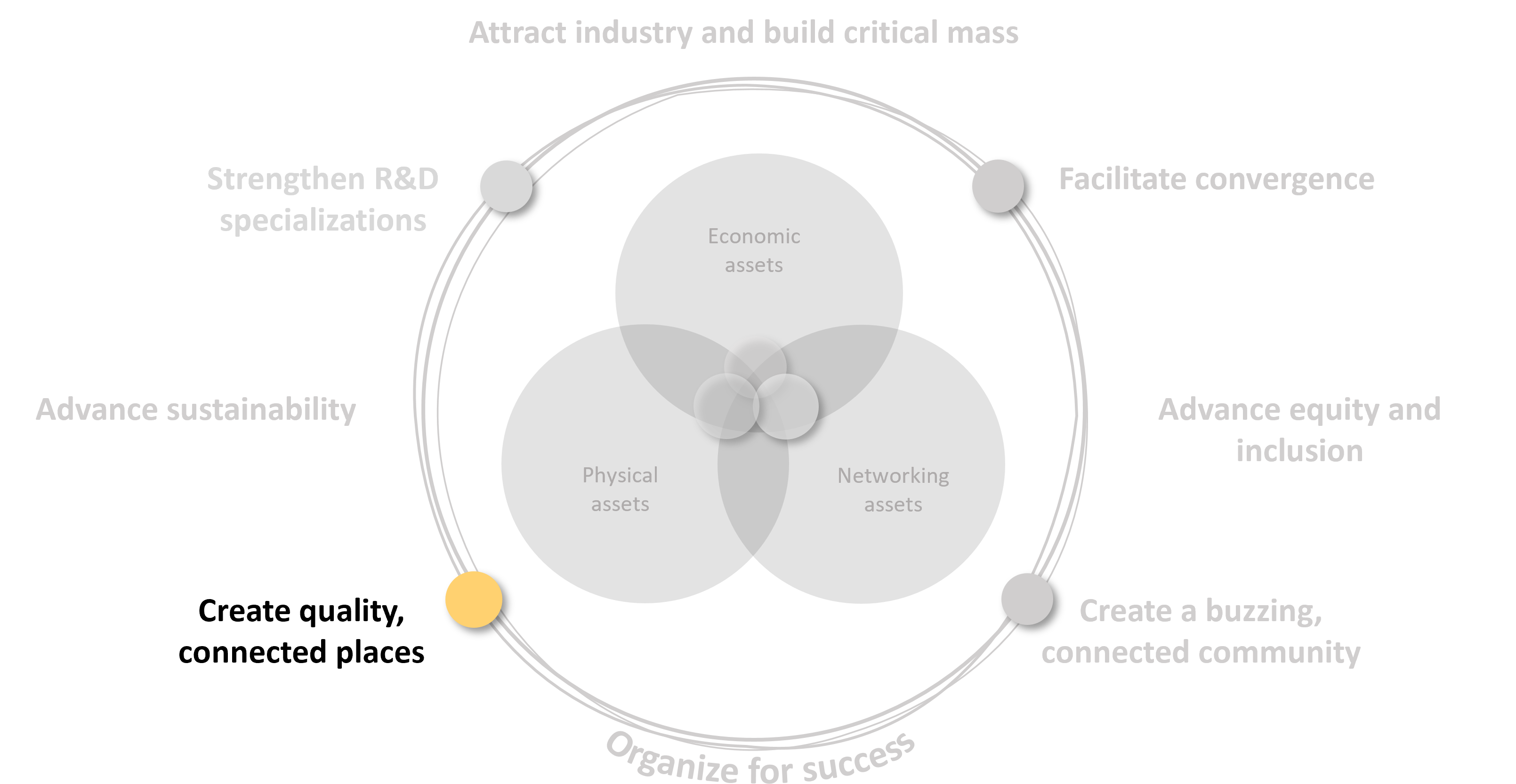
Organize for success
providing the foundational support for all strategies.
This strategy entails shifting from organic, if not market-led, approach towards one that is more intentional, coordinated and synergistic.
The shift requires districts and their local leaders to:
– Set a vision and detailed ambitions
– Develop a governance structure
– Orchestrate sustainable financing including new revenue streams
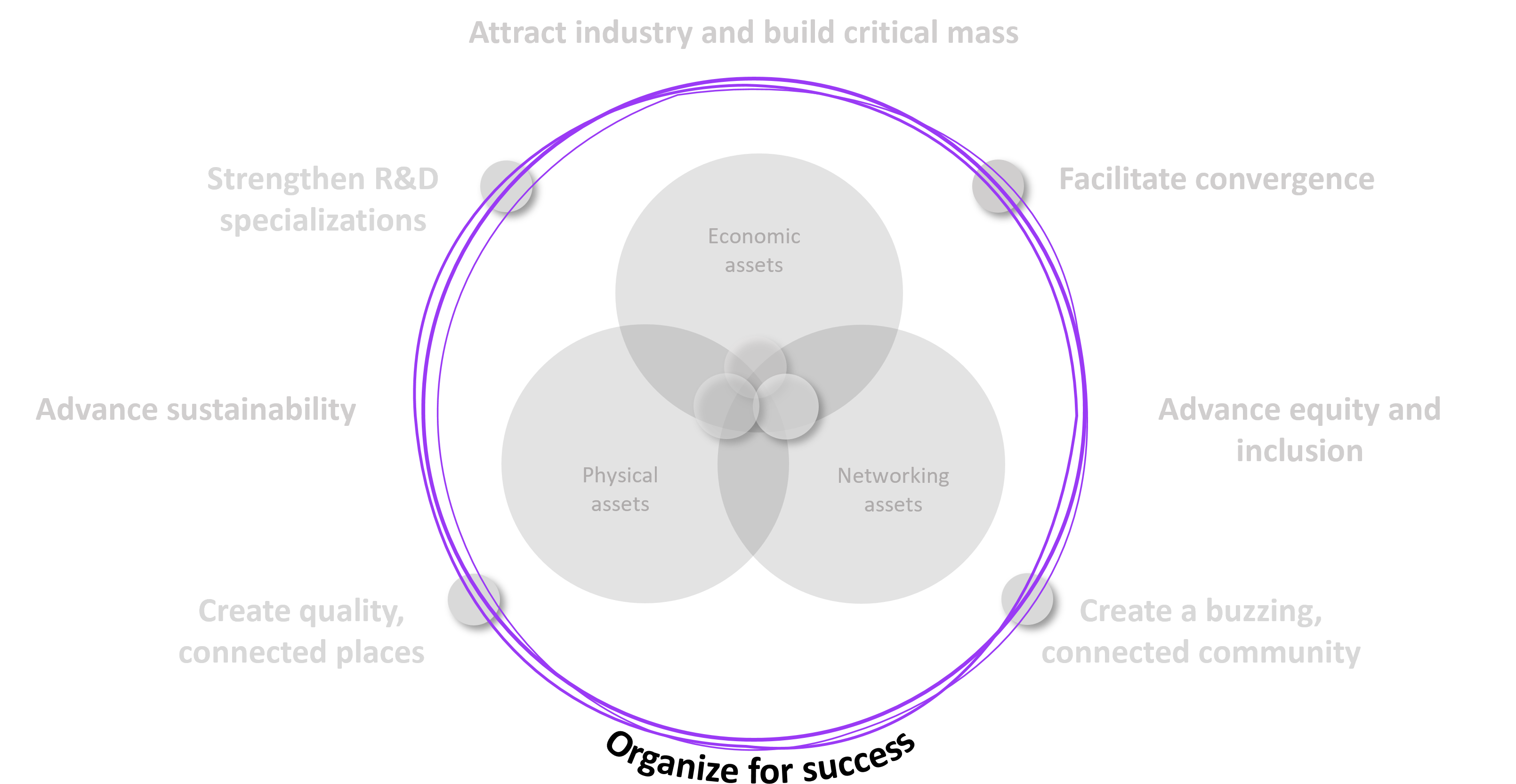
ㅤ
Districts use and deploy these strategies over time to strengthen their Unique Value Proposition. This clearly demonstrates why each district possesses distinct competitive advantages surpassing those of other innovation districts and geographies of innovation.
The value proposition of innovation districts is strengthened not only by a set of highly coordinated strategies and tactics, but also by the ambitions of district and community leaders. These leaders play a pivotal role in shaping the district’s direction, setting a bold vision, aligning diverse stakeholders, and mobilizing resources to activate growth and innovation.
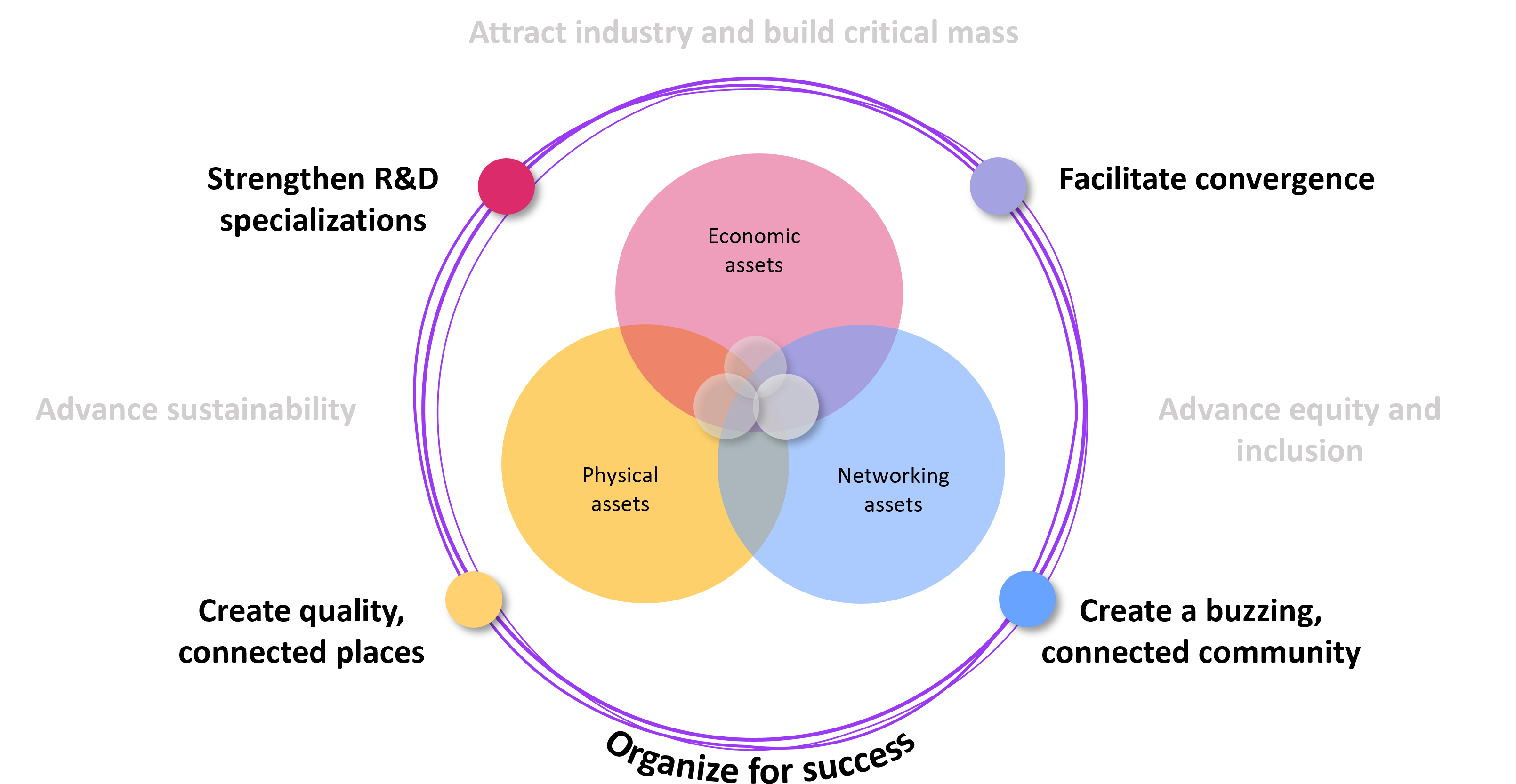
Core ambitions shaping a district’s Unique Value Proposition
Through our work with dozen of districts across over 15 countries, we have found that while each district has its own distinct identity, a core set of ambitions consistently emerges. This set is not exhaustive, as districts often pursue additional goals uniquely tied to their local context and specific circumstances. The following frames capture the most frequently cited ambitions that guide and drive innovation district development. Click the buttons below to learn more about each core ambition.
Attract industry and build a critical mass
of firms and talent that are aligned with the district R&D and other capabilities to solve highly complex problems.
A district’s ability to reach its full potential rests on its capacity to understand its unique specializations and to achieve a critical mass of companies, talent, and innovation infrastructure that align those specializations and enable them to flourish.
This goes beyond industry attraction and investment. Critical mass of the right kinds of actors with specific specializations, capabilities and drive is a far more orchestrated process.
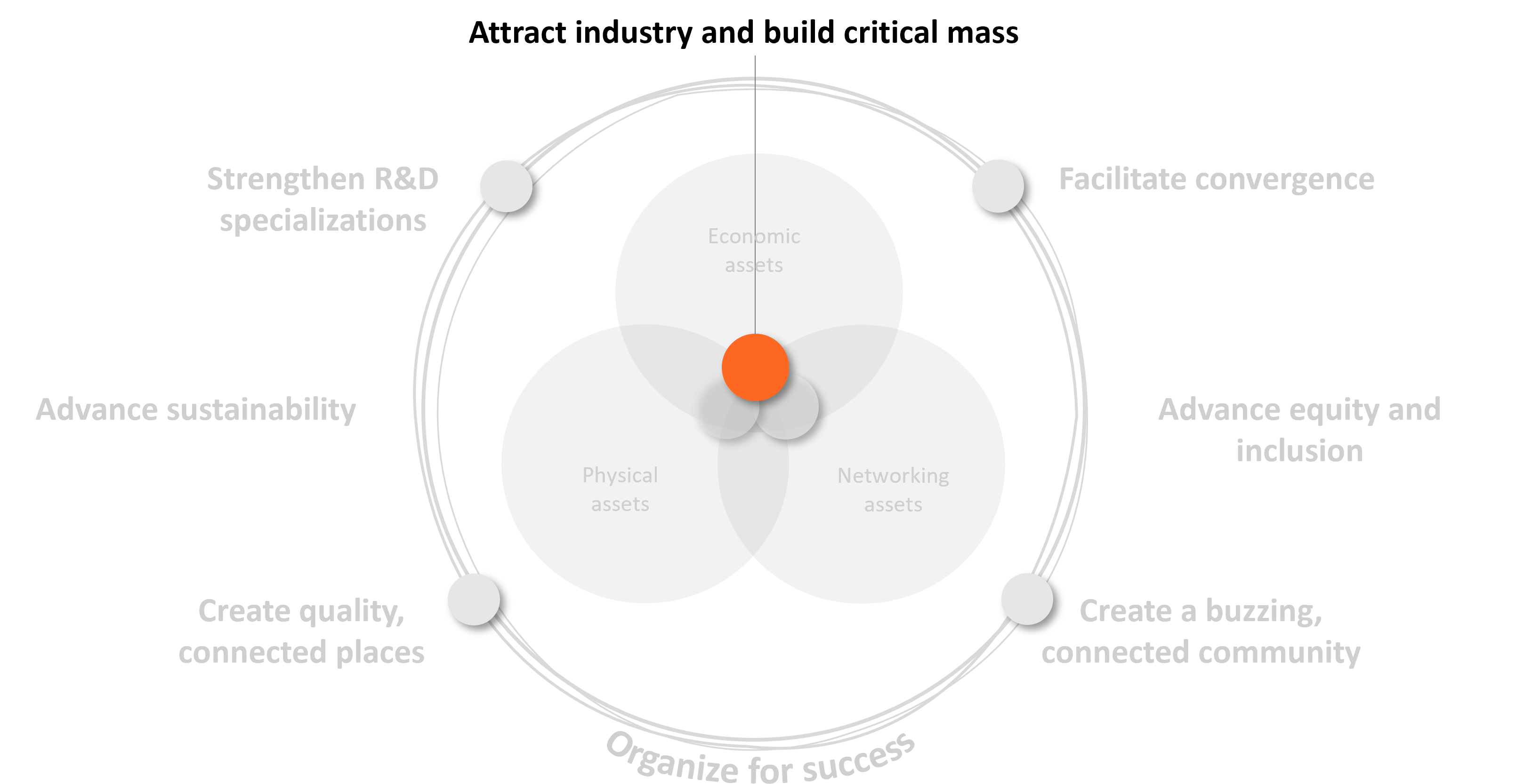
Advance equity and inclusion
playing a central role in taking on social, economic, racial and gender inequities prevalent in cities and regions.
The rise of innovation districts is occurring during a period of dramatic demographic transformation and economic restructuring. Combined, these create enormous income, wealth, and health disparities, both within and across cities.
The goal of the “inclusive city”—a city that expands educational and employment opportunities, creates wealth, shares prosperity, and engages residents as co-creators and problem solvers—is leading innovation districts to design, finance, and deliver tighter links between innovation and equitable growth.
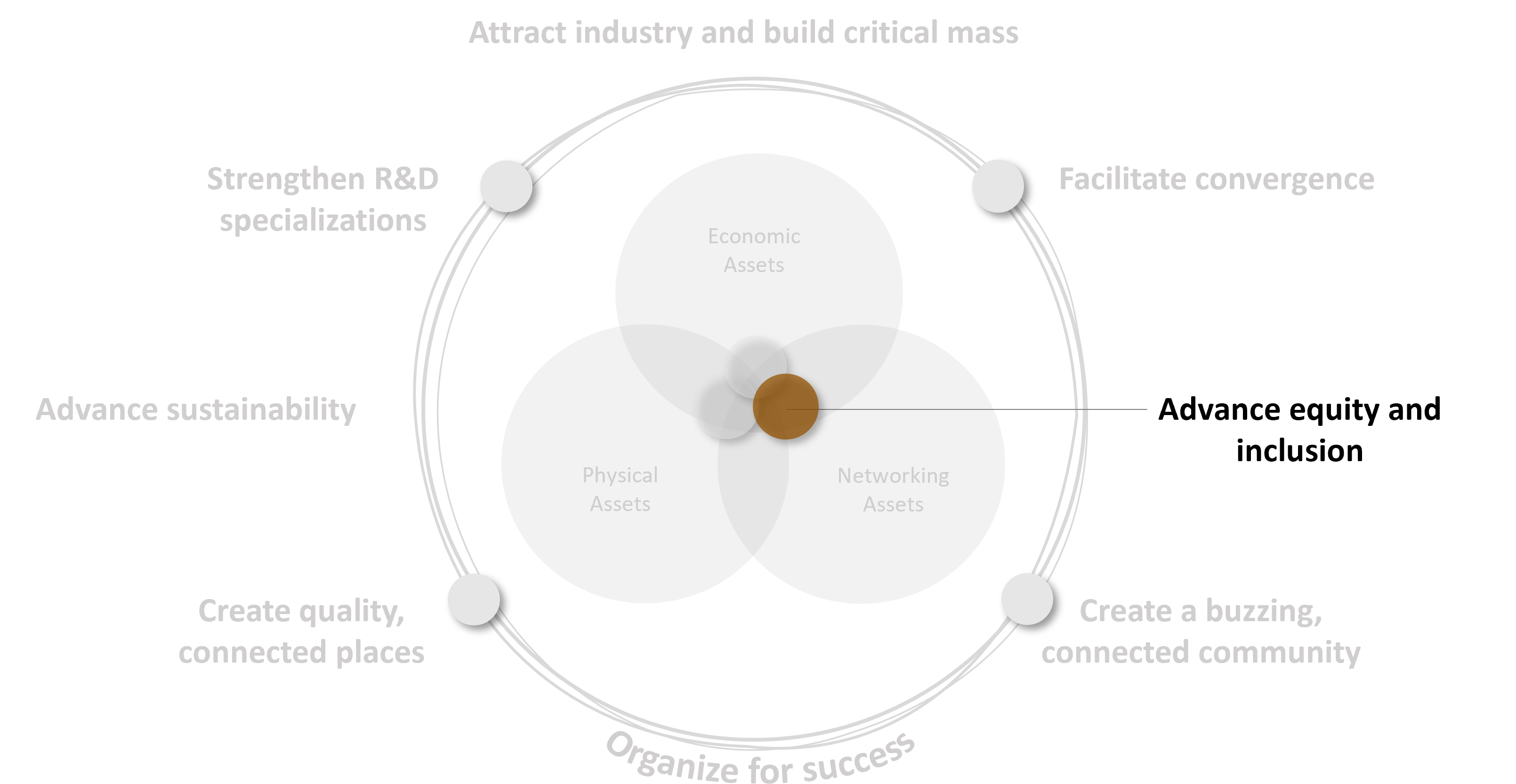
Advance sustainability
through a web of decarbonization strategies including the deployment of advanced R&D in climate and climate adaption solutions.
The combined R&D strengths of districts need to be deployed to develop, test, and scale new solutions in energy transition, climate adaptation, smart mobility, new materials, and more.
For emerging districts, a net-zero district is now considered a minimum requirement. Districts of the future should be the ultimate “living labs” that develop and scale new solutions, uniquely positioned to take on climate change.
In all districts, deliberate efforts to take on our warming climate will require strings of strategies, such as local housing choices to reduce commutes, renewable energies, green buildings, and the elimination of carbon-producing materials in buildings and across supply chains.

ㅤ
ㅤ
ㅤ
Districts pursue and evolve these ambitions over time to shape their Unique Value Proposition, demonstrating why each district holds distinct competitive advantages that surpass those of other innovation districts and innovation geographies.
A clear understanding of a district’s starting ambitions—grounded in existing strengths, capabilities, and long-standing investments—can shape how it will evolve, making it essential for leaders to intentionally define and cultivate these ambitions as core elements of the district’s strategic identity.
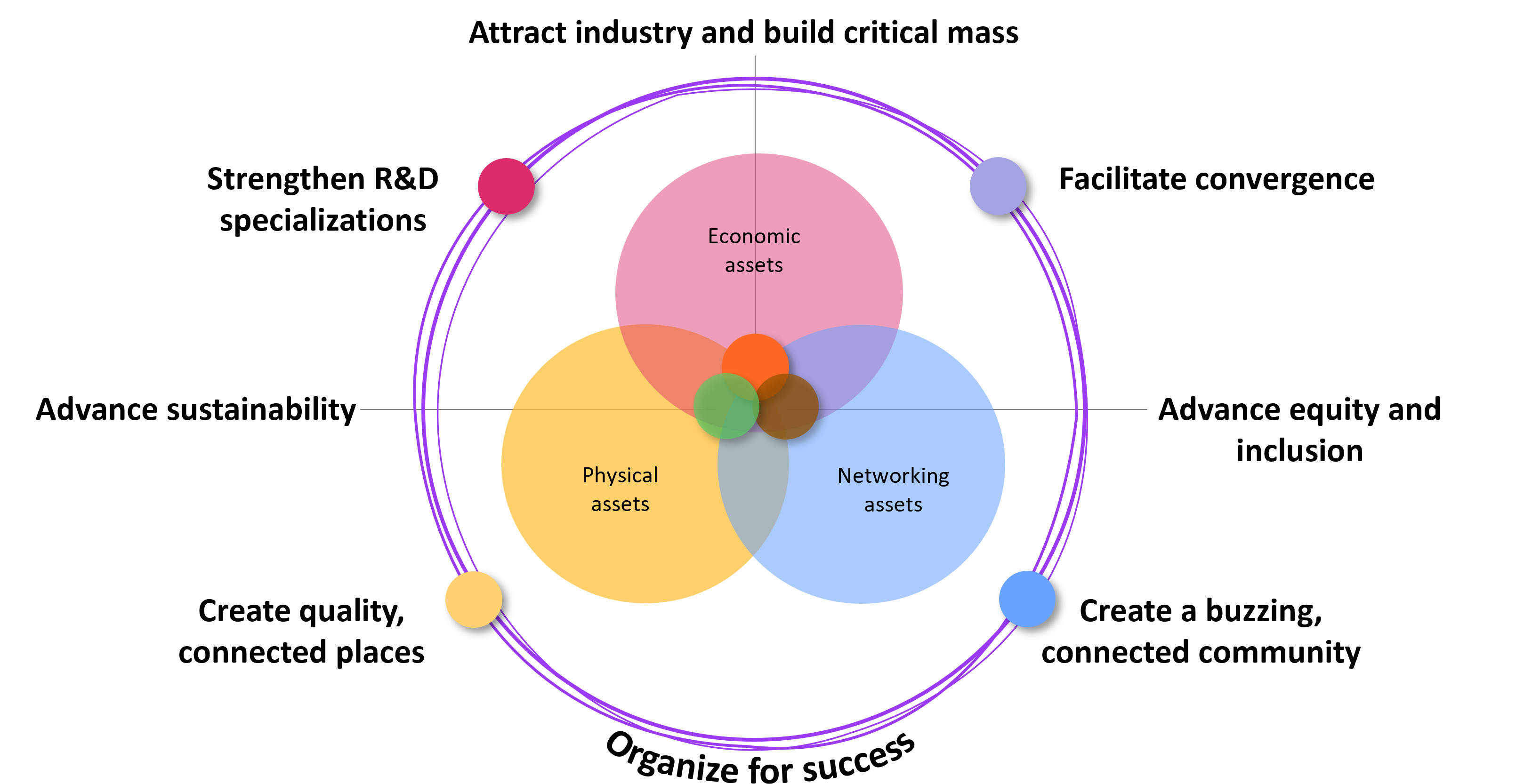

"Our Theory of Change is a blueprint to help innovation districts become centers of change and impact. This means organizing your district around the societal problems your district is best positioned to solve."
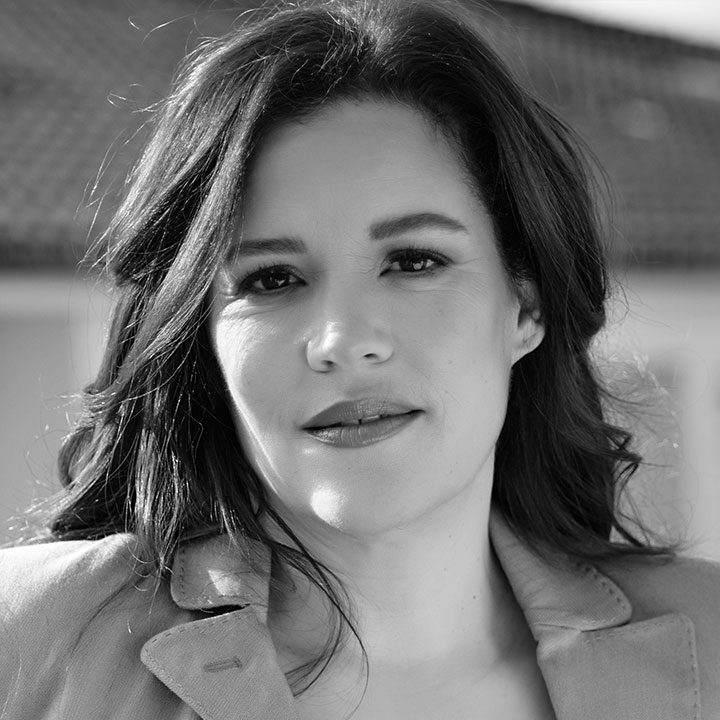
Julie Wagner
President, The Global Network of Innovation Districts
